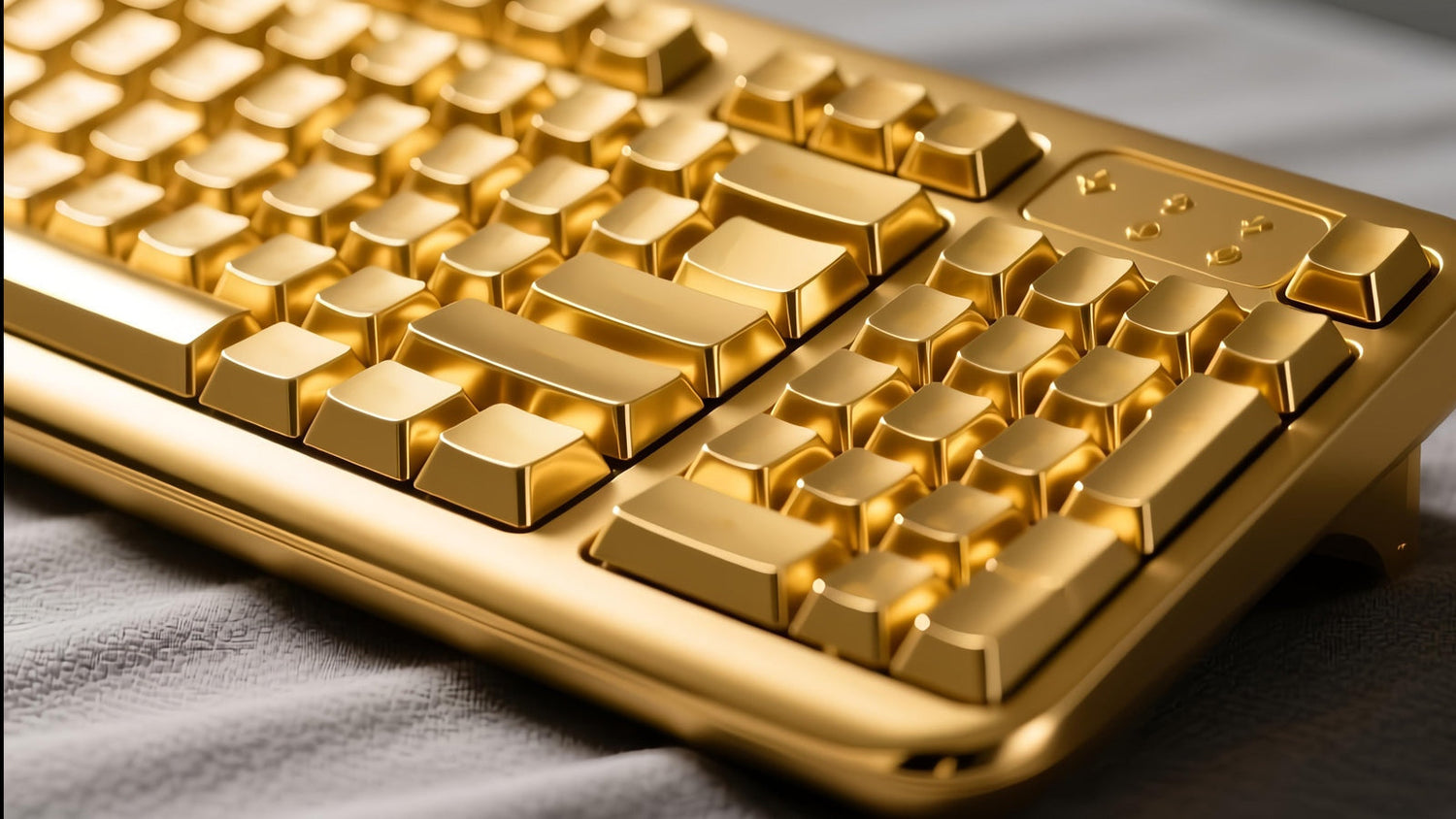メカニカルキーボードに適したケース選びは、見た目だけではありません。ケースの素材によって、キーストロークの感触、スイッチの音、そして快適なタイピング時間までもが変わります。プラスチックとアルミのキーボードデザインを比較検討しているビルダーや、真鍮製のキーボードのサウンドシグネチャーを検討しているビルダーにとって、これらの詳細を理解することは、コスト削減とフラストレーション軽減につながります。
ケース素材が重要な理由
キーボードケースは単なるシェルではありません。振動の伝わり方、音の共鳴、そしてキーボードが机上でどれだけ安定しているかを決定づけます。密度の高い素材はより深みのある音色を生み出し、軽くて柔らかい素材はより多くのエネルギーを吸収し、落ち着いた響きを生み出します。だからこそ、キーボードケースの素材選びは、愛好家の世界では重要な要素となっているのです。
プラスチックとアルミニウムのキーボードケース素材
プラスチック製のケースは、通常ABS樹脂またはポリカーボネート樹脂で作られており、軽くて温かみのある感触です。ABS樹脂は手頃な価格で、より柔らかな音色を生み出します。一方、ポリカーボネート樹脂製のキーボードは、より深く落ち着いた音色と評されることが多く、長時間のプレイでも快適だと感じるユーザーもいます。
一方、アルミニウムはカスタムキーボードの主流のスタンダードとなっています。机上でしっかりとした感触があり、より明るく、よりコントロールされたサウンドが得られます。アルミニウムの機械加工仕上げは共鳴を抑える効果もあり、安価なプラスチックにありがちな空洞のようなエコーを軽減します。多くのユーザーにとって、耐久性と安定したサウンドのこのバランスこそが、アルミニウムが依然としてベンチマークとなる素材である理由です。

アルミニウム以外の金属ケース:スチールと真鍮
特定のサウンドプロファイルを求める人にとって、スチール製と真鍮製のケースは別物です。真鍮製のキーボードの音は通常、低音域で重厚感があり、サスティンが長くなります。スチール製も同様の重厚感がありますが、慎重に調整しないとさらに明るい音になることがあります。これらの重い金属は非常に安定したタイピングプラットフォームを実現しますが、その密度のため、キーボードを移動したり、机の上で位置を変えたりすると疲れを感じることがあります。
ビルダーは、ケース全体ではなく、真鍮や鋼鉄を内部のウェイトとして使用することを好むことが多いです。この方法は、実用的ではないほどの重量を生み出すことなく、質量と共鳴の利点を実現します。
取り付けスタイルとケース材質
ケースの素材は単独で機能することはありません。プレートとPCBがケースにどのように接続されるか、つまりマウントスタイルが最終的なサウンドを形作ります。
- ガスケットマウントケースの素材の組み合わせにより、最も静かでクッション性のある打鍵感を実現。ソフトフォームまたはシリコンガスケットがタイピングプレートをシェルから分離し、より深く静かなプロファイルを実現します。
- トップマウントケースは、プレートを上部ハウジングに直接ボルトで固定します。これにより、よりしっかりとした感触と、やや明るい音色が得られます。
- トレイマウント設計はシンプルでコスト効率に優れていますが、シェルがプラスチックの場合、不均一な共鳴が生じることがあります。
-
一体型プレートはプレートとトップケースを一体化することで剛性を最大限に高め、チューニングの余地を少なくしています。適切な取り付けスタイルと素材を組み合わせることで、柔らかさ、明瞭さ、安定性のバランスを好みに合わせて調整できます。

サウンドチューニングとダンピング戦術
理想的なケースを使用していても、サウンドにはしばしば更なる調整が必要です。ケースフォームとプレートフォームは不要な共鳴を吸収します。PCBの背面にテープを貼ることでピッチが上がり、よりポップなサウンドが得られます。プレートとPCBの間にPEフォームを貼ることで、底打ち感が変化し、豊かな響きが得られます。
もう一つの効果的なアプローチは、フォースブレーク法です。これは、ケースの接触点に絶縁材を配置することで金属同士の共振を低減するものです。これらの制振技術を組み合わせることで、ユーザーはより細やかな制御が可能になり、プラスチックケースとアルミニウムケースの両方で同様の音響目標を達成できます。
キーボードケースの素材選びのための購入ガイド
次のビルドを選択するときは、材料だけでなく目標についても考えましょう。
- サウンドターゲット:落ち着いた深みのあるサウンドがお好みなら、ガスケットマウント付きのABSまたはポリカーボネート製が適しています。より明るく鮮明な音色をお求めなら、トップマウント付きのアルミニウムまたはスチール製がおすすめです。
- 重量と快適性:重い真鍮やスチール製のケースは安定性を高めますが、持ち運びが難しく、疲れの原因となる場合があります。軽量のプラスチックやマグネシウム合金は、携帯性と適度な共鳴のバランスを保ちます。
- 予算:射出成形ABSは手頃な価格です。CNCポリカーボネートはアルミニウムに近い価格です。チタンなどの特殊合金は、しばしば高額になります。
-
耐久性:アルミケースは耐摩耗性に優れていますが、傷がつきやすいです。プラスチックは落下時の耐久性は優れていますが、時間の経過とともに変形する可能性があります。これらの要素を比較検討することで、試行錯誤に無駄な費用をかけずに、キーボードケースの素材を絞り込むことができます。
新興・持続可能な材料:マグネシウム、チタン、複合材料
愛好家たちは、従来のセット以外にも様々な合金を試しています。マグネシウムは、金属のような質感を持ちながら重量はほんのわずかで、共鳴を損なうことなく持ち運びたい人に魅力的です。チタンは非常に剛性の高い構造で、シャープで響きの良い音色は、個性を重視するコレクターに魅力的です。
持続可能性の面では、再生プラスチックや低炭素アルミニウムが生産に導入され始めています。天然繊維とポリマーを組み合わせた複合材料も試験的に導入され、音質を損なうことなく責任ある代替品を提供することを目指しています。これらの方向性は、ケースの選択が音質だけでなく環境価値も考慮される未来を示唆しています。
ケースを選択して、今すぐ構築を開始しましょう
理想のタイピング体験への道は、ケースから始まります。音と感触の面で何を求めているかを明確にし、それに合わせて最適な素材と取り付け方法を選びましょう。必要に応じて制振性を試し、新しい持続可能な素材が登場したら、積極的に活用しましょう。ケース素材の役割を理解することで、すべてのキーストロークをより満足のいくものにし、すべてのセッションをより快適にすることができます。

メカニカルキーボードケースに関する5つのよくある質問
Q1. 温度や湿度によってキーボードの音は変わりますか?
A :はい。温度が高いとプラスチックがわずかに柔らかくなり、減衰が大きくなり、明るさが感じられるようになります。湿度が高いとフォームやパッドの質量が増加し、アタックが鈍くなり、減衰が長くなることがあります。金属製のシェルは形状を保ちますが、内部の充填材の変化も反映します。安定した乾燥した環境で保管およびテストを行ってください。
Q2. 金属製のケースはワイヤレス性能や ESD に影響しますか?
A :レシーバーを金属製の筐体の裏側に置くと、2.4GHz帯の信号が減衰する可能性があります。短いUSB延長ケーブルを使用し、ドングルを見通しの良い場所に設置してください。静電気放電対策として、USBシールドを通して適切な接地経路を確保し、接触点に絶縁塗料を塗布しないでください。
Q3. ねじや留め具を長期間保護するにはどうすればよいですか?
A :適切なサイズのドライバーを使用し、手でネジを締め込み、対角線に沿ってしっかりと締め付けます。締めすぎに注意してください。プラスチックの場合は、可能な限り真鍮製のインサートまたはヘリコイルを使用してください。金属の場合は、少量の低強度ねじロック剤を使用すると効果的です。ステンレス製の金具を使用する場合は、かじりを防ぐため、軽く潤滑剤を塗布してください。
Q4. さまざまなケース素材に安全なクリーナーはどれですか?
A :アルマイト加工のアルミの場合は、マイクロファイバークロスと中性洗剤を水で薄めてご使用ください。アルカリ性や研磨剤は使用しないでください。ポリカーボネートとABSの場合は、表面にひび割れや曇りが生じる可能性があるため、アセトンや強いアルコールは使用しないでください。継ぎ目周辺は十分に乾燥させ、フォームやパッドに水分が残らないようにしてください。
Q5. 自宅で音響を公平にテストするにはどうすればいいですか?
A :静かな部屋で、マイクをEnterキーから約15cm離して少し斜めに傾けて録音してください。すべてのテストで、机の表面、スイッチ、キーキャップ、プレートを同じにしてください。レベルを正規化し、 A特性のピークとFFTスペクトログラムを比較して、ピッチ、減衰、共鳴帯域を確認してください。



